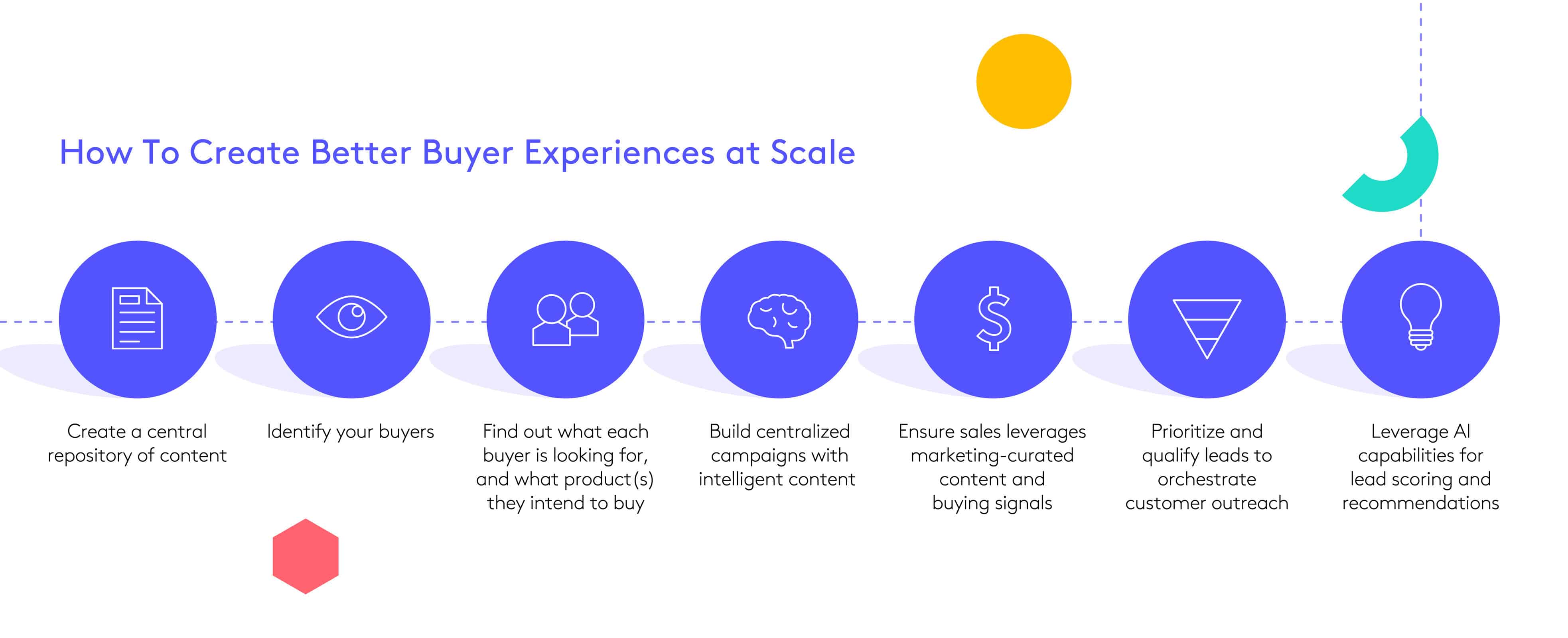
Changes To The Modern Buyer's Journey: Q&A with Caitlin Clark-Zigmond
As CEO and President of PathFactory, I’m lucky to cross paths with intelligent people across all sorts of industries. One of those people is Caitlin Clark-Zigmond, who most recently worked at Intuit as Director, Global Demand Center. She was featured in this Harvard Business Review article discussing how the modern B2B buyer journey is changing, and those buyers expect more than ever. Even a year later, these ideas still ring true. I sat down with Caitlin to get her thoughts on everything from the buyer journey to sales and marketing alignment (and everything in between).
“Using tools that provide AI-driven content insights and visibility into sales and marketing touchpoints is the real indicator that your go-to-market team is truly aligned.”
– Caitlin Clark-Zigmond
Q: We know the buyer journey is changing, but what do you think are the three biggest changes in recent years?
A:
- Personalization is taking on a new level of requirement in order to build trust. In our hyper-digital world, people are looking to be engaged in a way that feels personal and relevant to them.
- The fact that every customer’s experience needs to be an end-to-end experience. Whether it’s marketing, product, or sales, it’s very clear when a campaign isn’t integrated. When a B2B company doesn’t show up well and messaging is disjointed, it’s hard for customers to see the value the company provides.
- Finally, the importance of maximizing each moment you have your customer’s attention. For example, if you RSVP yes to a company’s webinar, and then you don’t hear from that company again until the webinar date, frankly that company isn’t doing enough to keep you engaged and interested.
Q: For companies working towards sales and marketing alignment—but aren’t quite there yet—what are sensible first steps a team can take?
A: Sales and marketing alignment sounds like a lot, but it can be as easy as getting your teams on the same page with the same data and goals. Start simple with these three steps:
- Get aligned on the opportunity: who are we going after?
- Find out what data you have on this group/segment/personas
- What does the journey look like for this target audience? What are the gaps, and how can the team collaborate to fill them?
Teams can build momentum and quick wins by finding things to align on, but don’t forget to include other teams as well, like customer success. That’s how you get the much-needed 360 degree view of your customer.
Q: Failing to personalize your customer outreach can lead to poor customer experiences, missed sales opportunities, and wasted effort. What do you consider perfect customer outreach?
A: I think about this in terms of lead and account scoring: marketing brings in leads, nurtures them, and the account gets scored. Teams will sometimes wait until an account reaches a certain threshold before they begin outreach, when really what should really be happening is marketing should learn what accelerates the leads and personas within an account with high lead scores, and what holds back accounts with low lead scores.
Another thing to consider at a go-to-market team is to increase the sales velocity of your deals by handing over some of your leads to a partner channel. The most important thing is to know when to tag in other teams. Sometimes I see sales teams trying to hold onto every lead, when really it can be an integrated approach between marketing, sales, and a partner channel, as the Partner is already the trusted advisor.
Q: How does content fit into the buyer journey?
A: Content is hugely important. Like most, I think of content in terms of top, middle, bottom funnel content: lead with your general topics; then go into mid-funnel content like thought leadership, white papers, case studies, and the content about the problems your customers have and the solutions they need. Then when the buyer is warm, they can move to bottom funnel content. At this point you can start to include sales in the creation, and can focus on video, demos and granular pain points end-users are trying to solve.
People think of content as blogs, whitepapers, or case studies, but it can also include SMS (text messages) or in product pop-ups—get creative with the ways you communicate with your buyers because that will help you stand out.
Q: What are other ways we can measure and track the success of a buyer’s journey?
A: I like to use customer delight as one of the metrics, and it’s applicable to the buyer journey and the post-sale customer journey just the same. In terms of post-sale, the best time to start the upsell/cross-sell conversation is when that customer hits delight (because sometimes vendors can start that conversation too early!). You can really use any metrics to calculate your customer delight—the number of times the customer went into the platform, how long they used it, individual license use within 30 days, etc. Use your platform’s data to find the things that are hindering your customers and prospects from reaching ‘delight’ and fix it.
If you want to apply delight to a buyer’s journey, look at variables like the length of the sales cycle. If your usual sales cycle is 30-60 days, you can understand how happy your buyers are if you start moving towards a 30 day cycle, for example. Since content is the fuel for your buyer journey, it’s important to regularly analyze your content’s performance and the content journey to see what chain of events leads to delight. This is much more robust than comparing engagement on individual pieces of content.
Q: You talk a lot about technology solutions and software that can help drive revenue. But can you have a successful marketing strategy and generate ROI on marketing tactics without the science side?
A: Marketing is an art and a science; it’s not one or the other. If you don’t have the art, you can’t apply the science and the data. I always hear people say that they need to be “data driven”, which is true to an extent, but if you’re using data to make decisions you’re looking at the past, not necessarily the future. Instead, I think it’s important to have access to real-time, useful data that you can use to make data-informed decisions, versus strictly data-driven decisions. Remember: marketing is never about having perfect information.

